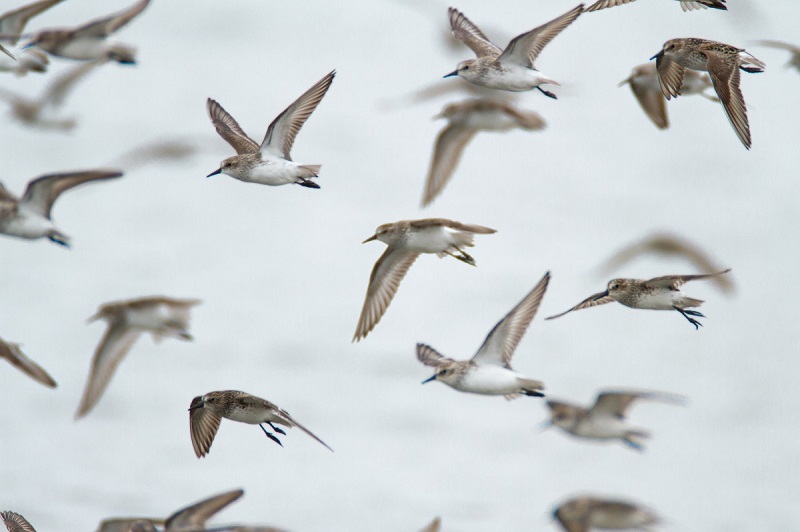


First Printed:
August 22, 1999
Deep in your bones you probably know the bad news already, but you don't want to hear it, not just yet. For those who watch birds, the signs first appeared in the middle of July. Spring has its harbingers, the robin and the bluebird. The earliest and ominous message of autumn is brought by the sandpiper.
The sandpiper conjures up memories of summer fun at the beach under warm blue skies. You stroll barefoot on the sand and feel the wavelets tickling your toes. There in front of you a little flock of birds runs before the reaching wave, as if afraid their tiny feet would be knocked from under them.
They are not afraid of the waves, which actually bring the sand dwelling insects to the surface, a meal for this voracious sandpiper. The name of those fast footed birds on the beach is actually sanderling, one of the many species of the family of shorebirds, more properly called waders.
These birds do a lot of wading, so the shore is a natural place for them to be, but their greatest asset is their wings. There is no group of birds that flies so fast and far and with such astounding endurance and agility. When you see them on the beach in July, they are not on their breeding grounds at all. They have already left behind the Arctic tundra and their young of the year. They are on the way to southern shores.
They arrived in the Arctic only 6-8 short weeks ago, found their old nesting territory, courted, mated, laid and hatched the eggs, watched over the small young for a while, then left them to start the long trip back. When these adult birds arrive at our shores, they are the heralds of autumn.
If you look down on the northern hemisphere from space, you see vast land masses and very little ocean. This is the tundra of Asia and America, where millions of waders find a vast open landscape, rich with insect life during the brief summer. There is enough for them and their just hatched young to feed on and fatten.
Eons ago this family of birds once lived only on tropical shores, but space was limited there and new birds could find no place to nest. They wandered north when the sun did and found new country for breeding, then those who retreated back from the cold and survived were able to repeat the process. It was the beginning of migration.
Eventually the vast bonanza of the Arctic summer was found, and now millions of waders of many shapes and sizes migrate the thousands of miles from there to the tropics every year. Because of that, the power of flight is their greatest asset. They have long narrow wings that bear the small but plump bodies through the air with ease, speed, and agility.
They stick together, often hundreds in a single flock, and as you watch, you can only marvel at the way the whole flock twists and turns as one, all spaced scant inches apart, but never touching even so much as a feather of another bird. Exactly how they do this is still a mystery, but researchers suspect some kind of magnetic sending and sensing ability keeps each bird instantly informed of the location, speed, and direction of their immediate neighbors in the flock.

The most abundant waders are the small sandpipers, all barely larger than a sparrow, and known informally under the name "peeps." The sanderling is one of the larger peeps, but it is rather specialized in liking the outer beaches. Most of the wading birds find much richer sources of food in the estuary, the shallow mud flats that are formed behind the protection of the barrier beach and dune system.
As the tide begins to fall they fly from resting places in the higher dunes and grasses, searching for the first appearance of mud, where insect and small invertebrate life flourishes in the shallows. When it appears, they land as one, spreading out evenly to pick and probe at the mud with their bills. They march as they fly, with cooperative precision and efficient effort, like an invading army.
There are many stories to tell of the sandpiper army, and you will read some here in the coming weeks.